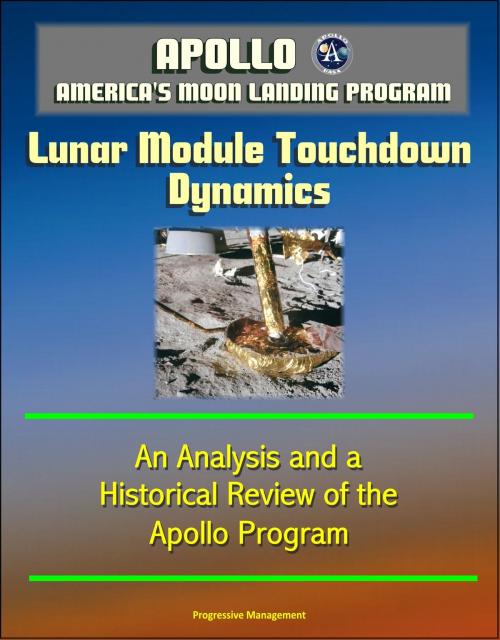Apollo and America's Moon Landing Program: Lunar Module Touchdown Dynamics, An Analysis and a Historical Review of the Apollo Program
Nonfiction, Science & Nature, Technology, Aeronautics & Astronautics, Science, Physics, Astrophysics & Space Science| Author: | Progressive Management | ISBN: | 9781311040664 |
| Publisher: | Progressive Management | Publication: | September 12, 2014 |
| Imprint: | Smashwords Edition | Language: | English |
| Author: | Progressive Management |
| ISBN: | 9781311040664 |
| Publisher: | Progressive Management |
| Publication: | September 12, 2014 |
| Imprint: | Smashwords Edition |
| Language: | English |
The primary objective of this paper is to present an analysis and a historical review of the Apollo Lunar Module landing dynamics from the standpoint of touchdown dynamic stability, landing system energy absorption performance, and evaluation of the first-order terms of lunar soil mechanical properties at the Apollo 11 landing site. The first-order terms of lunar surface mechanical properties consisted primarily of the surface bearing strength and sliding friction coefficient. The landing dynamic sequence started at first footpad contact. The flight dynamics data used to assess the Apollo 11 landing system performance and the lunar soil mechanical properties included the body axis pitch, roll, and yaw rate time histories as measured by the on-board guidance computer during the Apollo 11 Lunar Module touchdown maneuver, and the landing gear stroke data derived from post-landing photographs. The conclusions drawn from these studies were that the landing gear system performance was more than adequate from a stability and energy absorption standpoint for all Apollo lunar landings, and the lunar soil parameters were well within the limits of the design assumptions for all Apollo landing sites.
Chapter 1.0 - Introduction * Chapter 2.0 - Landing Dynamic Analysis * Chapter 3.0 - Drop Testing of Subscale and Full-scale Lunar Module Models * Chapter 4.0 - The Lunar Module * Chapter 5.0 - Critical Design Cases * Chapter 6.0 - Analysis of the Apollo 11 Lunar Module Landing Dynamics and Lunar Surface Mechanical Properties * Chapter 7.0 - The Apollo Lunar Module Landings * 7.1 Apollo 11 Lunar Landing * 7.1.1 Summary: Apollo 11 Lunar Module Landing * 7.2 Apollo 12 Lunar Landing * 7.2.1 Summary: Apollo 12 Lunar Module Landing * 7.3 Apollo 13 Lunar Landing (Aborted) * 7.4 Apollo 14 Lunar Landing * 7.4.1 Summary: Apollo 14 Lunar Module Landing * 7.5 Apollo 15 Lunar Landing * 7.5.1 Summary: Apollo 15 Lunar Module Landing * 7.6 Apollo 16 Lunar Landing * 7.6.1 Summary: Apollo 16 Lunar Module Landing * 7.7 Apollo 17 Lunar Landing * 7.7.1 Summary: Apollo 17 Lunar Module Landing * Chapter 8.0 - Author's Annotation - Apollo 16 and 17 Landings * Chapter 9.0 - Conclusions * Chapter 10.0 - References * Appendix A: Apollo 11 Lunar Module Touchdown Dynamics * Appendix B: Lunar Soil Mechanical Properties Model * Appendix C: Apollo 11 Lunar Module Mass Properties at Touchdown * Appendix D: Apollo 11 Lunar Module Landing Gear Load Stroke Characteristics * Appendix E: Apollo 11 Lunar Module Descent Engine Thrust Tail-off Characteristics
The primary objective of this paper is to present an analysis and a historical review of the Apollo Lunar Module landing dynamics from the standpoint of touchdown dynamic stability, landing system energy absorption performance, and evaluation of the first-order terms of lunar soil mechanical properties at the Apollo 11 landing site. The first-order terms of lunar surface mechanical properties consisted primarily of the surface bearing strength and sliding friction coefficient. The landing dynamic sequence started at first footpad contact. The flight dynamics data used to assess the Apollo 11 landing system performance and the lunar soil mechanical properties included the body axis pitch, roll, and yaw rate time histories as measured by the on-board guidance computer during the Apollo 11 Lunar Module touchdown maneuver, and the landing gear stroke data derived from post-landing photographs. The conclusions drawn from these studies were that the landing gear system performance was more than adequate from a stability and energy absorption standpoint for all Apollo lunar landings, and the lunar soil parameters were well within the limits of the design assumptions for all Apollo landing sites.
Chapter 1.0 - Introduction * Chapter 2.0 - Landing Dynamic Analysis * Chapter 3.0 - Drop Testing of Subscale and Full-scale Lunar Module Models * Chapter 4.0 - The Lunar Module * Chapter 5.0 - Critical Design Cases * Chapter 6.0 - Analysis of the Apollo 11 Lunar Module Landing Dynamics and Lunar Surface Mechanical Properties * Chapter 7.0 - The Apollo Lunar Module Landings * 7.1 Apollo 11 Lunar Landing * 7.1.1 Summary: Apollo 11 Lunar Module Landing * 7.2 Apollo 12 Lunar Landing * 7.2.1 Summary: Apollo 12 Lunar Module Landing * 7.3 Apollo 13 Lunar Landing (Aborted) * 7.4 Apollo 14 Lunar Landing * 7.4.1 Summary: Apollo 14 Lunar Module Landing * 7.5 Apollo 15 Lunar Landing * 7.5.1 Summary: Apollo 15 Lunar Module Landing * 7.6 Apollo 16 Lunar Landing * 7.6.1 Summary: Apollo 16 Lunar Module Landing * 7.7 Apollo 17 Lunar Landing * 7.7.1 Summary: Apollo 17 Lunar Module Landing * Chapter 8.0 - Author's Annotation - Apollo 16 and 17 Landings * Chapter 9.0 - Conclusions * Chapter 10.0 - References * Appendix A: Apollo 11 Lunar Module Touchdown Dynamics * Appendix B: Lunar Soil Mechanical Properties Model * Appendix C: Apollo 11 Lunar Module Mass Properties at Touchdown * Appendix D: Apollo 11 Lunar Module Landing Gear Load Stroke Characteristics * Appendix E: Apollo 11 Lunar Module Descent Engine Thrust Tail-off Characteristics















